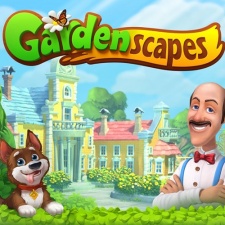This article was authored by Digit Games' Om Tandon. This article was originally published on LinkedIn.
You can see more Game UX Deconstructs here.
This is part two of a series. You can view part one, lessons from Angry Birds 2, here.
Why and how are casual games pivoting towards mid-core features? How are top tier Devs like Playrix driving this change in the casual gaming space? Here I have a close chat with Playrix, developer of top grossing games like Homescapes, Gardenscapes and Fishdom, to answer those questions.
The first part of this analytical series focused on Rovio Entertainment and how it successfully evolved and matured its multi-million dollar Angry Birds franchise.
In the second part of this article series, we put a spotlight on top 10 grossing casual games developer Playrix, which is trying hard to innovate and experiment with casual games, challenging the established norms of this genre, and finding profound success.

Playrix is known for a string of successful top 10 grossing hits like Homescapes, Gardenscape and Fishdom in highly competitive match-three category, dominated by the likes of King, Jam City and Peak Games.
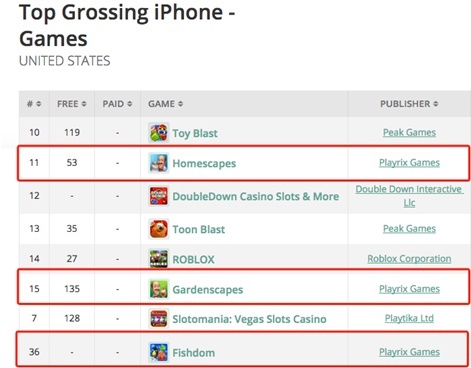
But unlike its peers, Playrix is not relying solely on eye candy graphics, super polished VFX and slick and dynamic gameplay which have become the pinnacle of this genre.
Instead Playrix is walking a different path.
Playrix: Recipe of success

Combining the simple core loop of match-three titles with unlockable decorative elements in a niche environmental setting, powerful daily quest system and a well-crafted story loop is strongly reminiscent of features used in mid-core and hardcore games. Let's see how.
Similarities with midcore Loops
Getting rid of the saga map in this genre and unlocking and populating the map with a decoration is very similar to a light version of base building tactics used by midcore and hardcore games. Here is how:
1) Light base building:
No Saga maps! Which have remained unchanged and are hallmarks of player progression in King and Jam City games. As seen below, Players start on Node 1 and progress linearly to the next node within each world as they clear subsequent levels, offering no other significant interaction.
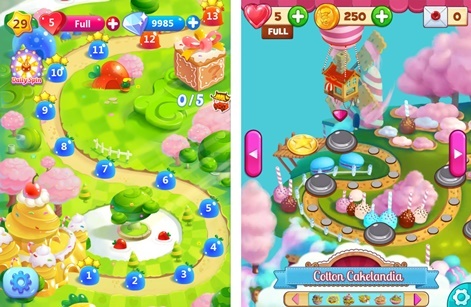
Q&A with Playrix team

Om Tandon: Why did you choose to move away from a Saga Map? What led the team to break away from this established cardinal rule of the Match 3 genre?
Igor Elovikov (Creative Director, Playrix): The roots of that decision date back to the times of casual downloadable games. Back then no one was even thinking about free-to-play mechanics and the market was saturated with lots of similar products. Companies wanted to stand out which led them to try blending genres.
One of the pioneers in that was Tropix. Both games were released in 2007 (over 10 years ago!) and had a lot in common - players had to beat match-three levels to earn currency and resources, which were needed in order to construct something. In Tropix it was an island, while in Cradle of Rome it was a whole village.
Actually, those two games inspired us when we created Fishdom, and then Gardenscapes, so what you see in our mobile games now is something that was actually tried and tested a long time ago.
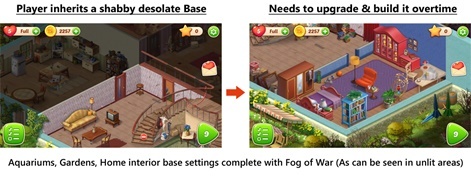
The exact mechanics seen in Playrix titles (first set of images) can be seen very commonly in midcore and hard-core games with base builder loops as seen in mobile hardcore game (second two sets of images below.)

Q&A with Playrix team
Om Tandon: Was the decision to add a light base building loop made consciously or found to work through trial and error?
Igor Elovikov: We just relied on our previous experience with casual downloadable games.
What precautions or change in design, if any, did you have to make to ensure these base building mechanics were not too overwhelming for casual players?
I guess the key things here are simplicity, and emotional appeal.
What I mean is that we tried to make the user experience as simple as possible - when it comes to building and constructing - and concentrate more on emotions.
In simpler words, we put more effort in the dialogue and animation of the fish in Fishdom and in storyline development in Gardenscapes, rather than in designing complex mechanics.
What is the feedback you get from your players? Do they find the decorative/light base building engaging compared to just match-three mechanics?
Well, I can’t say for sure. We definitely haven’t had any negative feedback, players haven’t told us that it bothers them, or that it gets in the way. Usually they say the game does differ, but in a positive way.
What they like is that the progress in the game is different from in the dozens of other match-three titles.
Do you believe it generates more value and engagement for your players? Do you see this appealing to existing match-three game players that are used to a saga map?
Yes, I believe so. My common sense tells me, when you put in a lot of effort developing a story full of characters, each with their own personality, it will definitely beat a regular saga map. At least in the emotional sense, it’s a great way to engage players.
2) Resource generation and XP gain
Structures in base building games are not just decorations, they also generate resources for the player hence a strong need to maintain and upgrade them, as seen in the Boom Beach example (bottom left).

As seen above, Playrix's Fishdom game (right image) has these characteristics, wherein some decorations like fish generate valuable soft currency, and adding each decoration also leads to the player gaining experience for progression.
Coins aid in core match-three gameplay, via buying plus-five moves, boosters, etcetera. Decorative structures can also be sold back in case the player is in dire need of coins, so they are liquid assets
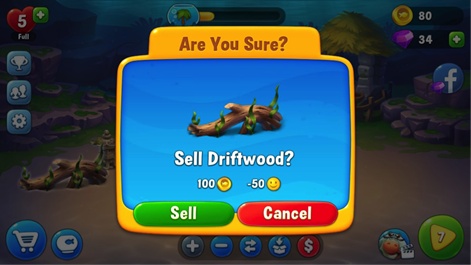
Q&A with Playrix team
Om Tandon: It’s interesting to see the differences in player progression in Fishdom and Homescapes, the way player deals with decorations and base building. Are there any specific reasons for these design changes?
Igor Elovikov: First of all, it’s all about what’s best for the setting. I think it’s the setting that determines what direction the progress takes.
Which of the two models, Homescape/Gardenscapes, with their fixed choices and options in terms of placement of decorations, versus Fishdom, with more choice in terms of placement and editing of decorations, work better from your experience?
I can definitely say that the limited freedom like in Gardenscapes is much simpler in terms of UI and user experience — which is critical for devices with smaller screens. It’s just easier to play on smartphones.
But the Fishdom scheme with a store and a wide range of content gives more opportunities for live ops. This type of model makes it a bit easier for us to design in-game events and come up with reward concepts.
While limited freedom in Gardenscapes, helps keep the UX simple on small devices, at the same time more varied store approach in Fishdom makes implementing live ops event rewards easier for developers.
3) Gating player progression
The primary means of gating is through the gradual unlocking of buildings based on player progression.

The Boom Beach and Fishdom examples above clearly show strikingly similar characteristics in their shops and their unlocking of advanced decorations and buildings via player progression.
Base building is an important aspect of the game, players need resources to build the base, which they earn in the main gameplay arc of battle, or match-three in case of Playrix.
Daily Missions & Quest System
Quests or daily activities systems bring the two loops together. They compel players through constant notifications to build and maintain the base (Home, Garden, Aquarium, etcetera.) and, as players need stars to do the chores, it directs them to earn the necessary stars via playing the match-three core.
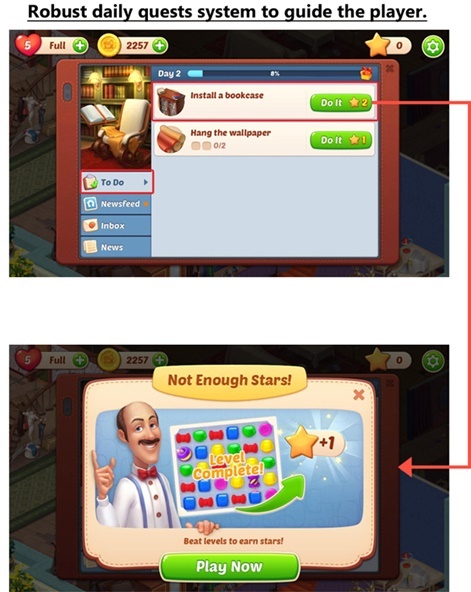
Quest systems are very commonly used in midcore and hardcore games to hand hold and guide the player to narrow down choices in terms of what to build or to do next in the game.
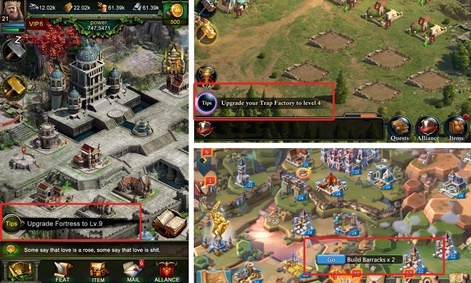
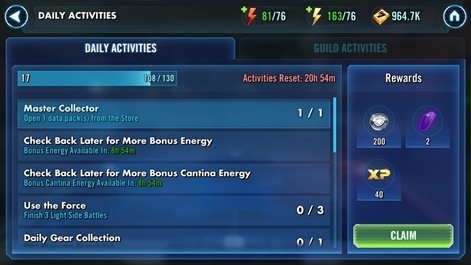
Examples from Clash of Kings, Lords Mobile, King of Avalon and Star Wars: Galaxy of Heroes above.
Q&A with Playrix team:
Om Tandon: Why the need for a daily quest system? Most other casual games in this genre totally lack this feature. I believe it seems essential for marrying the two loops, is that a true statement?
Igor Elovikov: I think daily quests are more of a universal tool. Its absence in other games doesn’t give them any kind of advantage. Any game as a service which is created for daily use will definitely benefit from having such a system.
Can the players who don’t care about base building and narrative skip the quest and base building totally and just focus on playing the match-three core? Why or why not?
Igor Elovikov: Yes, it is possible. We thought about making the two progresses sync with each other, i.e. making the metagame progress mandatory, but we gave up on that idea.
Our data shows that all players do something with design, construction and quests to a certain degree. Very few users completely skip that part.
Easing the Experience
1) Playrix has been careful in moderating and toning down the base building aspect so it does not become too overwhelming for the players while still providing more variety in gameplay and introducing dual arcs of progression for the player. Progression comes via completing levels and building of the map.
2) The Quests system is kept to a minimum. No more than two quests are available at a time so as not to create a choice bias for the casual player. Heavy hand-holding and predetermined choices in base building reduce the cognitive load for the player while introducing the player to these newer mechanics.
In essence Playrix has successfully inherited and adapted the base building and quest driven aspects typical of midcore and hardcore games and married them intelligently and effectively with their own spin on casual games!
This approach seems to be proving a hit with the maturing pool of veteran casual games players and is adding more long-term revenue generation.
This also proves casual players can be intentionally matured to move towards more midcore mechanics by light introduction of such features.
Q&A with Playrix team
Om Tandon: Do you think the bulk of the casual gaming audience is looking for more than what other casual games are offering today?
Igor Elovikov: I think so. First, because they are satiated with lots of identical games. All players, including casual ones, are looking for new experiences.
Do you see yourself experimenting more with the genre? If yes, is there anything you may want to share based on your learnings with other devs, and future trends you foresee?
We’re continuing to experiment, trying out different methods to progress and with game session management, but it’s too early to say something for sure now.
In the future, I think we’ll see a lot of interesting approaches to the genre, not only from Playrix and not only from games like Fishdom and Gardenscapes. It may be a new approach to casual games, but it is definitely not new for the industry in general.
That is why developers are drawing from the MMO experience, session-based games etcetera... adapting their mechanics. Mechanics such as daily quests, regular events, clans and others are universal. They have long ago proved that they work for player retention, which is crucial for any free-to-play game.
Apart from creating novelty value, do you think your strategy of engaging and maturing casual players to more mid-core mechanics also helps improve monetisation and long-term sustenance?
Definitely. The latest changes that King has made to Candy Crush and our experience are proof of that.
Speaking of King, in the last year they have put a greater focus onto live ops. Apart from releasing new levels, they have added a lot of regular activities to the game. Now every time you log into Candy Crush there’s something going on. The game pushes you to beat levels with the help of plentiful time-limited rewards.
Some of the major additions King has included are the redesigned Daily Quests, win streak rewards and competitions between random players against the number of levels they beat in a certain time period.
From the first and second part of this series player maturity and genre maturity appears to be a rising trend. In the third part of this series we will analyse and talk to yet another casual games developer who has taken this path and found profound success.
Special thanks to contributors and co-ordinators:
Igor Elovikov (Creative Director, Playrix) LinkedIn
Ivan Titov (Brand Manager at Playrix) LinkedIn

